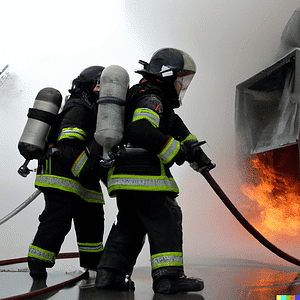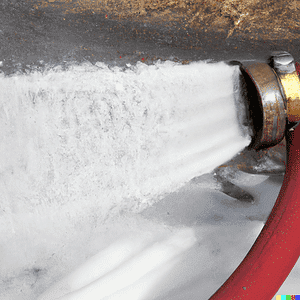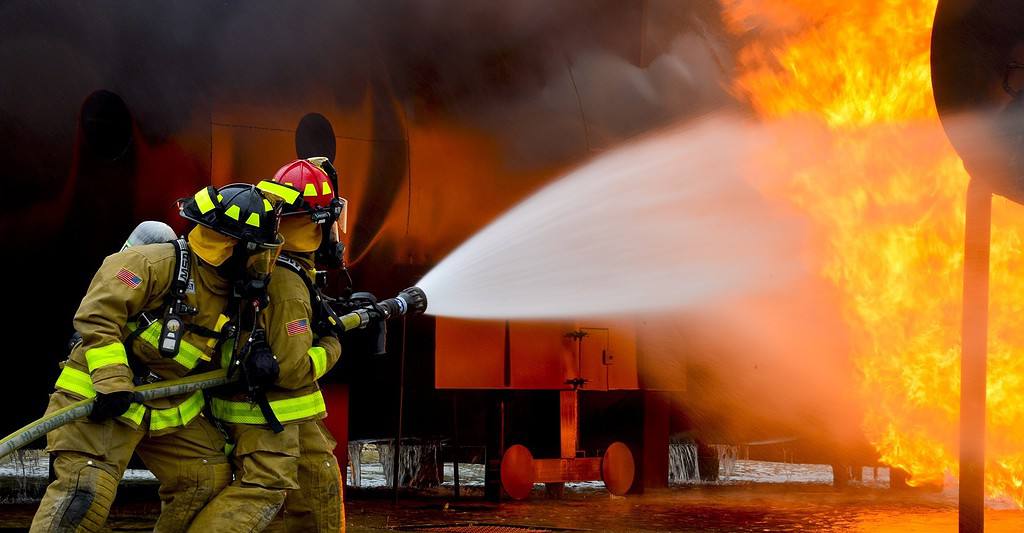Civilian and military fire departments have relied on Aqueous Film-Forming Foam (AFFF) to put out fires for many years. Numerous organizations used AFFF firefighting foam in both actual fires and training settings.
Unfortunately, AFFF-related chemicals can accumulate in the body over time. These hazardous chemicals can significantly raise your risk of contracting acute, life-threatening diseases like cancer.
You might bring an AFFF firefighting foam lawsuit against negligent producers like Dupont, Tyco, 3M, and others if you were diagnosed with cancer or another ailment after being exposed to firefighting foam.
This post will discuss everything you need to know about AFFF lawsuits. Read on to learn about what to do after being diagnosed with cancer linked with exposure to AFFF.
What Is AFFF (Aqueous Film Forming Foam)?
Aqueous Film-Forming Foam (AFFF) is a product that helps stop fires that cannot be put out with water alone. It contains perfluoroalkyl and polyfluoroalkyl substances (PFAS) -chemicals that aid in putting out the fire.
These chemicals are still being used in firefighting foams despite available evidence that they pose a cancer risk. AFFF was created to help put out fires faster than previous techniques. In fact, it is still used today for this purpose in many installations.
Sadly, the risks might outweigh the possible benefits, particularly if the chemicals seep into groundwater or wash off into surrounding land, which can pose significant threats to locals.
Some risks posed by exposure to AFFF include prostate, pancreas, renal, and testicular cancer. The most frequent cancers linked to AFFF exposure include testicular and kidney cancer.
What Is AFFF Firefighting Foam Used For?
AFFF was developed to help in quicker fire suppression than other available techniques. It is still utilized for that purpose in many installations.
The Department of Defense (DOD) claims it uses this firefighting form on airplanes and ships because the closeness between people, fuel, and weapons may be particularly dangerous.

AFFF immediately disperses throughout the fuel’s surface and deprives the fire of oxygen. Even huge flames are rapidly put out with AFFF. Additionally, the AFFF foam stops the hot fuel from reigniting.
Unfortunately, the risks might outweigh any possible benefits, particularly if the chemicals seep into the groundwater or flow off into surrounding land, which could pose significant concerns to locals.
What Problems Can AFFF Foam Cause and How?
Fire-extinguishing chemicals can attach to blood proteins and remain in the body for a prolonged period. These chemicals are non-biodegradable; it can take eons to eliminate them from the soil and underground water.
The majority of firefighters have up to nine different fluorinated substances in their bloodstream, thanks to exposure to AFFF. Any of these chemicals can potentially increase your risk of cancer, including:
- Breast cancer
- Lymphoma
- Leukemia
- Non-Hodgkin’s Lymphoma
- Kidney cancer
- Pancreatic cancer
- Testicular cancer
- Liver cancer
- Ovarian cancer
- Prostate Cancer
- Bladder cancer
Firefighters are directly exposed to these chemicals. They ingest them in several ways, including by inhaling, skin contact, or oral ingestion, which is unavoidable when putting out fires.
Firefighters must adhere to strict safety guidelines to help reduce exposure and the effects of potential exposure to these chemicals.
These safety guidelines include donning protective gear before using fire extinguishers that contain PFAS, taking a bath, and wiping the skin immediately after exposure to the chemicals.
Firefighters have moved to replace their current fire suppression systems with fluorine-free alternatives.
High-Risk Professions for AFFF Firefighting Foam Exposure
Firefighters make up the majority of people who are exposed to high amounts of AFFF. Many of them are not informed of the possible risks connected to the use of AFFF.
Instead, they are trained in using specialized firefighting techniques without appropriate warning about the long-term effects of chemical exposure.
Navy
The Navy has been using AFFF since the 1960s. In addition to using AFFF to put out natural fires, Navy personnel also uses the substances in training exercises to teach the appropriate responses to fires.
Exposure to these chemicals through training ultimately increases the risk of developing cancer.

The Navy preferred using these chemicals because of their capacity to contain jet fuel fires, which can quickly spiral out of control without fire suppression assistance.
But today, the US Navy is taking measures to shift away from PFAS-containing chemicals. Unfortunately, the Navy continues to employ many of these poisons while exploring viable options.
Airport workers
Airports have used AFFF in their fire protection systems for many years. Most stopped in 2018, when information regarding the potential carcinogenic effect of exposure to AFFF firefighting foam emerged.
Many personnel at those airports, notably emergency responders and those who cleaned up after those fires, were likely exposed to hazardous firefighting foam.
AFFF Firefighting Foam Exposure in Groundwater and Drinking Water
It may take eons for AFFF to completely fade from the environment because it does not break down on its own. It may seep into the soil and nearby groundwater in regions where it was used.
In some circumstances, this can result in residents being exposed to such dangerous substances. The concentration of these substances remains extremely high around Navy bases or in locations where firefighters often practice.
Private individuals should consult their physicians and speak with an attorney to discuss their rights if they suspect they may have cancer due to exposure to AFFF chemicals.
Filing an AFFF Lawsuit: Who Bears Liability for AFFF Use?
Many organizations that use AFFF, such as local fire departments, might not have known much about the possible adverse impacts of those substances.
On the other hand, those fire control systems manufacturers may have known the risks for a long time.
Despite being aware of this, these companies did nothing to safeguard the public, such as the firefighters who risked their lives to extinguish the fires and save lives and property.
The Dangers of PFAS in AFFF Firefighting Foam
Since they do not degrade, perfluoroalkyl and polyfluoroalkyl substances (PFAS) have been dubbed “forever chemicals” and have drawn attention recently. Even if PFAS degrades, it may take years.
There is strong scientific evidence connecting PFAS exposure to kidney, prostate, thyroid, ovary or endometrium cancers, non-Hodgkins lymphoma, pancreas, leukemia, and testis.
PFAS exposure via AFFF firefighting foam is also said to cause thyroid disorders and alters the human immunological system.
PFAS chemicals typically end up in the soil, eventually polluting the local water supply. Since PFAS compounds do not naturally degrade over time, municipalities are finding it quite expensive to mitigate PFAS pollution.

People living in nearby areas are frequently exposed to these harmful chemicals and known carcinogens daily because they drink and bathe with contaminated water.
According to research published by the environmental protection agency (EPA), there have been close to 900 discharges of AFFF firefighting foam into different US rivers.
The EPA has recorded 897 pollutant emission incidents in the country’s water supplies. The extent to which harmful substances and recognized carcinogens have contaminated our water supplies is unknown.
Obtaining Compensation Through an AFFF Lawsuit: The Compensation You Deserve
Contact a knowledgeable personal injury lawyer as soon as possible after receiving a cancer diagnosis connected to that exposure to AFFF.
A personal injury lawyer can help you understand the precise compensation you are entitled to and the appropriate parties to contact for damages.
Most personal injury lawsuits have the same fundamental components, including cancer claims spurred on by AFFF exposure.
Medical bills
A personal injury claim must include your medical expenses; with a cancer diagnosis, these expenses can accumulate quickly. Most cancer patients require numerous procedures as well as more extended hospital stays.
Surgery, radiation, or chemotherapy can be required. Some doctors even recommend undergoing immunotherapy, a costly procedure that helps advance cancer treatment.
Other patients seek palliative care which helps reduce symptoms and increase their comfort throughout treatment. You are entitled to reimbursement for the medical costs associated with your cancer treatments in your claim.
Lost wages
Some cancer patients are forced to take a temporary leave of absence. While some of them can continue to work part-time while receiving treatment, others may find it hard to balance their therapies with continuing to work full-time.

You may continue losing more income as your battle with cancer progresses. Some companies will let you work part-time while you receive treatment, but you can lose a significant portion of your regular pay during those times.
Pain and suffering
During their therapies, cancer patients endure a considerable lot of discomfort. Numerous cancers cause significant suffering, but the treatment also causes additional suffering for the patient.
Many victims also miss out on scheduled activities and events due to their frailty brought on by their disease or cancer treatments.
As they undergo therapy, victims may also have to cope with the loss of interactions because they do not have the time or energy to interact with friends and loved ones.
Your lawyer can advise you on whether you can include the pain and suffering you have undergone after your diagnosis in your firefighting form lawsuit.
Why Seek Compensation for AFFF-Related Damages?
As a firefighter, you probably took your job seriously to protect those close to you: to put out fires, prevent property damage, and save lives.
As you tried to save lives and lessen possible threats, you may have frequently exposed yourself to high quantities of those chemicals, primarily if you served as a Navy or airport firefighter.
However, the industries that manufactured such chemicals did not take the essential precautions to safeguard you.
AFFF can still be used frequently, particularly in risky environments where the risks brought on by fires may outweigh the potential dangers from AFFF exposure.

This should be done with the proper safety equipment and precautions, such as restricting the movement of AFFF materials to protect groundwater and keep local citizens safe.
Unfortunately, manufacturers failed to take the appropriate precautions to safeguard firefighters and other people exposed to those chemicals. Exposure to AFFF can leave you nursing a severe illness.
A cancer diagnosis, in most cases, changes and limits individuals for the rest of their lives. Cancer can often result in death, mainly if it develops to an advanced stage before you get a diagnosis. It would be best if you get reimbursement for the losses you sustained.
If you have received a severe diagnosis due to your exposure to AFFF, contact Legal Giant to learn more about your legal entitlement to compensation.
AFFF Lawsuit Settlement Amounts – What Can Victims Expect
For beginners, AFFF’s manufacturers are unwilling to settle. Bellwether trials are currently scheduled, with the first trial slated for April 2023. A bellwether trial will allow both sides to understand how a jury would determine other cases within the AFFF MDL.
However, once some bellwether cases result in jury verdicts, one party (defendants) will likely start considering a potential AFFF settlement to avoid exposure to other firefighting foam lawsuits that may go either way.
The AFFF lawsuit settlement will likely be determined by several factors related to the kind and severity of cancer. Although it is still too early to anticipate the settlement value precisely, we may make educated guesses based on how other mass tort cases have ended.
We predict the typical AFFF lawsuit settlement will be more than $150,000. Additionally, the usual jury verdict might surpass $1,000,000.00.
However, only a small percentage of mass tort claims go to trial due to the danger and expense involved.
Two Categories of Plaintiffs in a Potential AFFF Settlement
Category 1 of AFFF Settlements
- Municipal firefighters
- Commercial firefighters
- Military firefighters
- Private government contractors operating near military bases
- Residents of communities near where firefighters may have trained to deploy firefighting foam that gradually seeped into the ground and polluted drinking water
Category 2 of AFFF Settlements
- Municipalities whose land and water supplies were contaminated with AFFF
How an AFFF Attorney Can Help
A skilled personal injury lawyer can help you pursue compensation for your cancer diagnosis from exposure to AFFF.
A lawyer can:
· Help you understand your legal rights
How much financial support do you deserve following a cancer diagnosis? Should you file a class action lawsuit or file personal injury lawsuit? What should you do if the AFFF manufacturer offers a lowball settlement?
Your legal counsel can assist you in making choices that will safeguard your financial future and legal rights following major health issues connected to AFFF exposure.
· Fight for you
You will most likely need a lawyer to fight for fair reimbursement. Organizations frequently respond better to attorneys than to complaints from individuals.

A lawyer can fight for the compensation you are owed and, if necessary, help you file a firefighting foam lawsuit. Additionally, a lawyer may advise you on when to accept a settlement offer and the potential effects on your financial future.
-
Reduce stress and provide you peace of mind during the process
You already have too much to deal with after receiving a cancer diagnosis. Having a lawyer to deal with your diagnosis’s legal process can bring peace of mind.
You will realize that working with an accomplished personal injury attorney frees you up to cope with your rehabilitation instead of concentrating on legal concerns.
Recent Updates on The AFFF Firefighting Foam Lawsuit MDL
November 3, 2022 – AFFF Lawsuit Update
The first AFFF bellwether trial, slated for June 5, 2022, was preceded by some mediation conferences set up by Judge Gergel. The MDL Judge chose Layn Phillips to mediate and lead the first-ever worldwide firefighting foam settlement.
Generally, the settlement of a firefighting foam lawsuit might be divided into two groups. One would be PFAS exposure from individual users of AFFF firefighting foam.
This would include people exposed to contaminated water and firefighters whose occupation exposes them to these chemicals.
The municipalities’ expenses for cleaning up contaminated water sources full of hazardous chemicals would make up the second AFFF compensation class. That means AFFF lawsuit settlement amounts might be so high.
October 16, 2022 – AFFF Lawsuit Update
Judge Gergel chose the first bellwether trial on October 16, 2022, and the defendant is a typical culprit, 3M Company. To begin with, the city of Stuart is north of Palm Beach in Florida.
In the City of Stuart v. 3M Company, the city claimed that 3M was to blame for the town’s water supply containing contaminants like PFAS. Additionally, the City of Stuart is suing for financial compensation to cover the costs of removing toxic substances from its tainted water system.

Several other municipalities have brought AFFF firefighting foam lawsuits owing to water contamination resulting from the negligence of Chemours, Tyco, 3M, and Chemguard.
The producer of the AFFF firefighting foam, in this instance, is 3M, and its chemicals seeped into the water system of the municipality, contaminating it. The first bellwether hearing for AFFF firefighting foam will be held on June 5, 2023.
September 29, 2022 – Update on AFFF Cancer Lawsuits
The most recent AFFF MDL update is that Judge Gergel dismissed 3M’s government contractor defense. 3M used this as a defense because they produced AFFF firefighting foam under a government contract.
3M further claimed that the government contractor defense granted complete protection from firefighting foam lawsuits. Judge Gergel, however, denied 3M’s petition for summary judgment.
According to Gergel, the government contractor defense does not apply since the company withheld information regarding the health risks of firefighting foam. About 2800 AFFF firefighting foam cases were closed in September as part of the AFFF MDL.
This was a significant legal barrier that may have ended many AFFF litigation. The biggest producer of AFFFs could be 3M.
The continuing AFFF litigation may move forward with all 3M firefighting foam lawsuits. Judge Gergel would have denied 3M’s request, which would have prevented thousands of people from pursuing AFFF compensation.
Get Legal Help Filing Your Firefighting Foam Lawsuit
You might have a valid claim if you or your loved one were diagnosed with cancers following exposure to AFFF firefighting foam.
You need an experienced attorney to help you with enough evidence to prove your firefighting foam lawsuit. At Legal Giant, we partner with the best attorneys dedicated to getting you the compensation you deserve.
Contact us today for a free consultation and review of your case.

